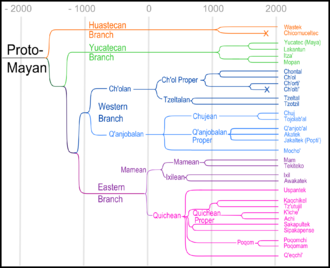
Back نموذج الشجرة (لغويات) Arabic Stammbaumtheorie German Keelepuu ET مدل درختی FA Keelepuu FIU-VRO Családfamodell (nyelvészet) Hungarian Teori stammbaum ID Teoria dell'albero genealogico Italian 系統樹説 Japanese Forma stemmatica LA

In historical linguistics, the tree model (also Stammbaum, genetic, or cladistic model) is a model of the evolution of languages analogous to the concept of a family tree, particularly a phylogenetic tree in the biological evolution of species. As with species, each language is assumed to have evolved from a single parent or "mother" language, with languages that share a common ancestor belonging to the same language family.
Popularized by the German linguist August Schleicher in 1853,[1][2] the tree model has always been a common method of describing genetic relationships between languages since the first attempts to do so. It is central to the field of comparative linguistics, which involves using evidence from known languages and observed rules of language feature evolution to identify and describe the hypothetical proto-languages ancestral to each language family, such as Proto-Indo-European and the Indo-European languages. However, this is largely a theoretical, qualitative pursuit, and linguists have always emphasized the inherent limitations of the tree model due to the large role played by horizontal transmission in language evolution, ranging from loanwords to creole languages that have multiple mother languages.[1] The wave model was developed in 1872 by Schleicher's student Johannes Schmidt as an alternative to the tree model that incorporates horizontal transmission.[3]
The tree model also has the same limitations as biological taxonomy with respect to the species problem of quantizing a continuous phenomenon that includes exceptions like ring species in biology and dialect continua in language. The concept of a linkage was developed in response and refers to a group of languages that evolved from a dialect continuum rather than from linguistically isolated child languages of a single language.[2]
- ^ a b List, Johann-Mattis; Nelson-Sathi, Shijulal; Geisler, Hans; Martin, William (2014). "Networks of lexical borrowing and lateral gene transfer in language and genome evolution". BioEssays. 36 (2): 141–150. doi:10.1002/bies.201300096. ISSN 0265-9247. PMC 3910147. PMID 24375688.
- ^ a b François (2014).
- ^ Cite error: The named reference
waveswas invoked but never defined (see the help page).